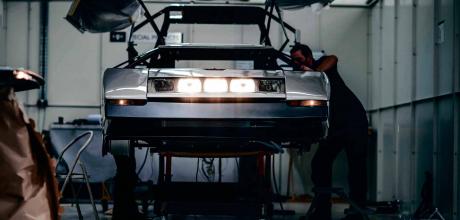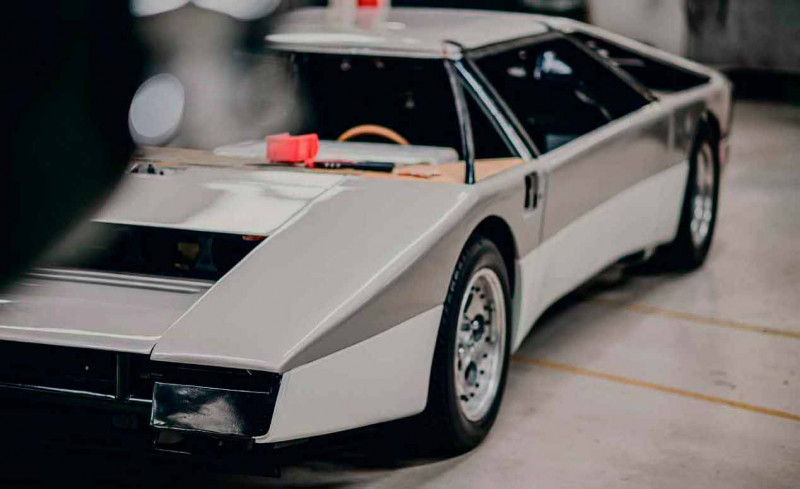Bulldog resto all the latest progress, and a look back at the press reception in Spring 1980

The body panels are on, the wiring is in, and the engine is back together – Bulldog’s restoration enters the home straight. Photography Words John Simister AMY SHORE/CMC.
Light show
RESTORATION BULLDOG
‘The doors go on today,’ says Nigel Woodward, head of Classic Motor Cars of Bridgnorth where the Bulldog is undergoing the most painstaking of resurrections. It’s not the first time the powered gullwing doors have been on during the Bulldog’s time at CMC. There was the first fit when the doors had been repaired, de-rippled and painted in primer, and the second after any necessary adjustments and corrections had been made. Now, resplendent in their final colour coat, comes their final fit.

As Nigel takes me into the workshop where the Bulldog half-hides under a multi-coloured spider’s web of wiring awaiting a home and final taping-up, I see that the rear-hinged tail section, also in its final finish, is already attached so its alignment with the doors can be checked.
It will have to come off again before the engine and gearbox can go in. Before that happens – and in the next few days as I write on 27 July – the other outer panels will join the tubular chassis, the new glazing from Pilkington will be bonded into position and the Bulldog will look, from the outside at least, almost complete. Photographs will be taken, with the results you see on these pages. Electrics wizard Craig Brush is wrestling with the air-conditioning, wiring and dashboard entrails all around.
‘It’s from a 1970s Cadillac,’ he says. ‘I’ve got the diagram here, but the connections for the vacuum pump are different.’ This is the original pump, its function to power the various-moving flaps as the slider controls in their very US-looking console are operated. Those sliders have detents in their action, but during the Bulldog’s original build two of the depressions were filled in to make them inoperative, and the corresponding labels expunged. One of them was for the ‘eco’ setting, presumably deemed off message for a 200mph supercar with a large glass area and the potential for much heat-soak.
Meanwhile, Craig has already got the LED instruments working. ‘Most of the cables had dropped off the back, and there are no markings. I emailed the manufacturer in Mexico but got no reply, so we’ve had to figure it out for ourselves.’
Back at the nose, Nigel points out the giant heater blower motor and the two original hydraulic door lift pumps. ‘They’re like something off a forklift, and not short of power,’ he says. ‘They were leaking all over the place before we rebuilt them,’ adds Craig. Then there’s the bank of new cooling fans, the rebuilt radiator with new-military- spec screw-on hose fittings, and the new pair of electric water pumps. These replace the single engine-powered one, creating much-needed space in the congested engine bay.
Also in the nose is a new pump – so many pumps – to raise the ride height by up to two inches, by pumping up the spring platforms of the new Protech adjustable coilovers. ‘Now it will be able to run at the designed ride height,’ Nigel explains, ‘while still being able to negotiate speed bumps. It’s been sitting too high for years.’ Then he gets Craig to demonstrate the five Cibié Iode headlights and their drop-down cover, still skeletal pending the panel work. ‘We’ve had to do some clever electronics for the headlamp flash,’ Nigel says. ‘The cover used to take a while to drop, by which time the flashing moment had passed. Now it’s quick enough for a usable flash function.’
We look inside the cabin again, where Nigel points to the handbrake. ‘We’ve re-engineered the linkage from the back of the cockpit rearwards,’ he tells me. ‘It used to have cables, but now it’s hydraulic, which will be more reliable and have a better action.
‘We’ve improved the gearshift, too. Originally the engine had an exhaust manifold from a car with US emissions equipment, on which there was a pipe at the bottom for exhaust recirculation. On the Bulldog this pipe was repurposed to hold the back of the gear linkage. Now there’s a new bracket with two spherical bearings. When Stirling Moss drove it back in the day, he said it was a great car but the gearshift was horrible. That might have been because the exhaust heat was making the linkage bind. It should be much better now.’
Next stop, aft of the cabin. There are three mounting lugs for the top of each spring/damper unit but only two are used, as you would expect. What’s going on? ‘We’ve moved the pivot point back to give more clearance for the engine – and now we can use the front brackets to mount the spare-wheel carrier.’ Very neat.
Also very neat will be the packaging for the pair of not-yet-fitted intercoolers that the Bulldog originally lacked. They will sit just behind the doors and ahead of a pair of slim-dry-cell batteries – ‘better than the single heavy one that used to sit right in the tail,’ Nigel points out – and will be fed liquid coolant circulated from a tank by a pair of electric pumps. ‘And we’ll use the space where the old battery was for two oil coolers, one for the engine, one for the transmission. It will double the transmission’s oil capacity.’
All the suspension has been checked for full articulation without touching anything it shouldn’t, and it has been laser-aligned. The front suspension includes fabricated lower arms, upper wishbones ‘possibly from a Jaguar XJ6’, and uprights probably from a Towns-era V8. At the Bulldog-bespoke rear, CMC has beefed-up the wheel bearings. ‘They were trying to use a new idea back then, a single-row bearing, but that’s asking an awful lot of the bearing. So we’ve changed to two-row bearings which are much more stable.’
The new replica wheels have arrived, and Nigel shows me the scuffing and ovalling of the Compomotive-made old ones’ stud holes. ‘It’s as if it had been driven with the wheel nuts loose,’ he says. The new wheels have steel inserts for the stud holes, just in case. AP Racing doesn’t make the original design of brake discs any more, so they too have been replicated by CMC’s secret army of bespoke suppliers.
And – a major step forward for the project – the 700bhp V8 engine is back at CMC and being built up. The original aluminium block, which was a little corroded at the base of the iron cylinder liners as is usual with these V8s, has been rescued and strengthened. ‘There has been an enormous amount of precautionary engineering,’ Nigel reveals. ‘It has a new steel crankshaft, Omega pistons and Arrow conrods, which are lighter and stronger. We’ve done a lot to get rid of rotating mass.
‘We have designed a new and unique “girdle” for the bottom end, which fits between the block and the sump. When we took the engine apart we saw that the bottom of the block had spread. Was it over-revved or was this just the result of 700bhp? Either way, we don’t want that happening. New billet main-bearing caps will bolt through this girdle.
‘At the top of the block we’ll replace the original cast valley plate with a new one machined from billet, and the heads will be sealed to the block with Wills rings as well as a head gasket.’ Wills rings have been used for many years in high-stress applications; they are hollow steel rings filled with argon at around 1000psi.
The flywheel and clutch are new, designed to take a pair of smaller-diameter clutch plates instead of a single large one. This will both increase the clutch’s torque capacity and reduce its rotational inertia, which will speed the gearchange and reduce the loads on the synchromesh.
And talking of unwanted loadings, CMC noticed that the centre line of the bellhousing didn’t line up with that of the crankshaft. Possibly to accommodate the misalignment, the crankshaft was missing the spigot bush into which the gearbox input shaft normally fits. The resulting noise and vibration hardly bears thinking about. ‘So we made a big aluminium tool to line up the gearbox centre with the crankshaft,’ says Nigel. ‘We’ll only use it once but it had to be done. And that was followed by a lot of remedial work on the bellhousing.’
So, what is the plan from here? CMC wants to get every one of the Bulldog’s parameters set as accurately as possible before final assembly and the first test run take place, so there are no tripwires and the Bulldog stands the best chance of working properly straight out of the box. ‘The rough plan is to finish assembling the car by the end of next month [August as I write], set it up and de-snag it, and run it at a military air base in the UK.
‘I’ll drive it first, up to reasonable speeds, then Darren Turner will take it as fast as we can in the UK.’ After that, assuming it all works properly, will come the 200mph run that the Bulldog never quite achieved in period.
‘The venue hasn’t been decided yet. In 1980 the idea was to go to Volkswagen’s test track at Wolfsburg with its 8km straight, so that’s a possibility. So is Nardo in southern Italy, an 13km bowl. And by the time we’re there we’ll be into winter, so it will be cooler. That’s a good thing.’
The Bulldog is inevitably moving further away from its original specification as the restoration progresses, but with every change it stands a greater chance of fulfilling its creators’ dreams thanks to modern technology and knowledge unavailable in 1980. ‘We’re making prototype parts to replace prototype parts in a prototype car,’ Nigel observes, ‘so there may be some interesting problems. Who knows?’
One thing is certain, though. In its glass-smooth silvery gold over a very fine pearlescent white, the Bulldog at full chat is going to look fantastic.
Above and right Lifting the vast front windscreen, made by Pilkington, into position before it is bonded into place. Right: 1980 and the motoring press puts the Bulldog through its paces at MIRA.
Below and right Painted panels are fitted for the first time. Going clockwise from right: reassembled V8 with one of the twin turbos visible just beneath the cylinder head; installing the digital instruments and wiring loom, and the new twin-plate clutch.

